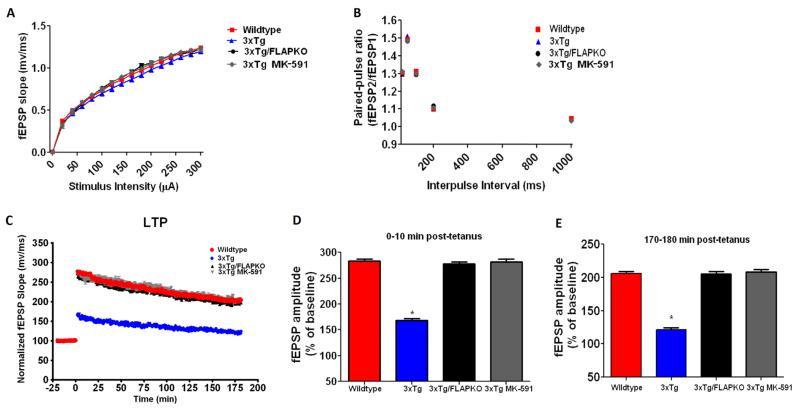Figure 6.
Genetic absence or pharmacologic inhibition of 5-lipoxygenase activating protein (FLAP) rescues synaptic dysfunction in triple transgenic (3×Tg) mice. (A) Input/output (I/O) curves and representative field excitatory postsynaptic potentials (fEPSPs) at increasing stimulus strengths (0–300 μA) are shown for wildtype and 3×Tg mice, 3×Tg mice genetically deficient for FLAP (3×Tg-FLAPKO), and 3×Tg mice treated with MK-591 at 6 months of age. (B) Mean fEPSP slopes as a function of interpulse interval between the first and second fEPSPs evoked at CA3–CA1 synapses in slices from the same mice at 20, 50, 100, 200, and 1000 milliseconds in the same animals. (C) fEPSP slopes were recorded for 3 hours and expressed as the percentage of pretetanus baseline in the same mice. (D) Long-term potentiation (LTP) magnitudes expressed as the percentages of baseline for 0 to 10 minutes posttetanus (274.6% ± 8.5% for wildtype, n = 23 slices; 159.9% ± 13.8%, n = 19 slices for 3×Tg; 269.7% ± 10.3%, n = 21 slices for 3×Tg-FLAPKO; 272.5% ± 13.2%, n = 10 slices for 3×Tg-MK-591). (E) For the same groups of mice, LTP magnitudes expressed as the percentages of baseline for 170 to 180 minutes posttetanus (202.6% ± 6.5% for wildtype; 121.0% ± 3.4% for 3×Tg; 197.1% ± 11.5% for 3×Tg-FLAPKO; 156.9% ± 6.9%; 202.5% ± 9.4% for 3×Tg-MK-591; *p < .0001). Values represent mean ± SEM.

